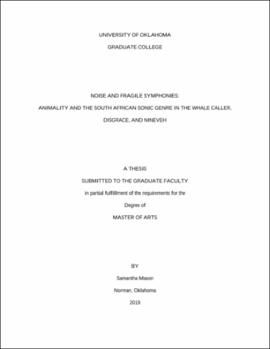| dc.description.abstract | When establishing an interspecies ethics, it is often the gaze that is used to establish the agency of the animal Other in the absence of logocentric speech. However, when considering the physical realities of the nonhuman animal, which is often defined by noise and listening, the sonic genre—speech, music, and noise—is just as fruitful a place to analyze animal agency. While humans can never inhabit the mind of the animal Other, the sonic genre, particularly music, serves to render their experiences as comprehensible, and therefore important to humans. In this paper, I use the sonic genre to analyze three works of post-apartheid South African literature: Zakes Mda’s The Whale Caller, J.M. Coetzee’s Disgrace, and Henrietta Rose-Innes’ Nineveh. In The Whale Caller, the sonic genre largely manifests in the form of music, which provides a connection between characters, both human and animal. While this music does inspire an interspecies ethics of identification between the eponymous character and the whale Sharisha, it also leads to a romanticized anthropomorphism—the misconception that she somehow is more than a whale—which ultimately leads to her death. In Disgrace, the repeated failure of the language of the colonizer causes the protagonist David Lurie to rely on music as the main vehicle for ethics. Through music, Lurie is able to imagine the experience of the another being: a disabled dog called Driepoot who is soon to be euthanized. While this act of generosity is a relatively small gesture, it is something Lurie is incapable of doing in his human relationships. Finally, Nineveh’s primary engagement with the sonic genre is through noise and its ability to permeate boundaries meant to keep the animal Other out. While the protagonist Katya, a pest controller, begins the novel with an interspecies ethics of removal over extermination, by the end of the novel, even this attempt to separate species is suspect. Instead, Katya adopts an ethics of cohabitation, living nomadically with a dog named Soldier. In these three novels, the sonic genre establishes three distinct forms of interspecies ethics through the protagonists’ relationships with nonhuman animals. However, to rely on human interpretations of the noise of the animal Other is not enough to create a positive interspecies ethics. While there is a much to be learned about the nonhuman animal through these works, to act ethically, one must also respect the alterity of the animal Other.
Keywords: sonic genre; interspecies ethics; post-apartheid South African literature; Zakes Mda; J.M. Coetzee; Henrietta Rose-Innes | en_US |

